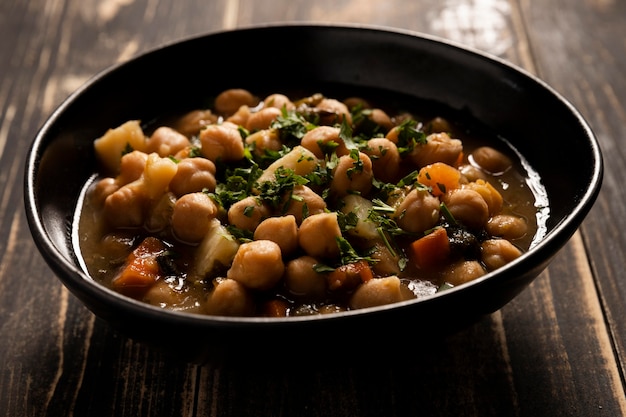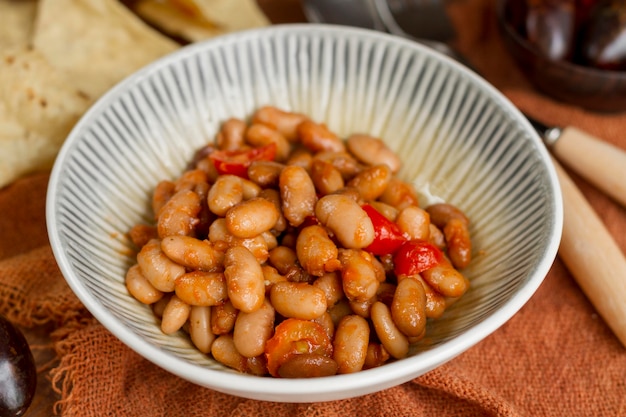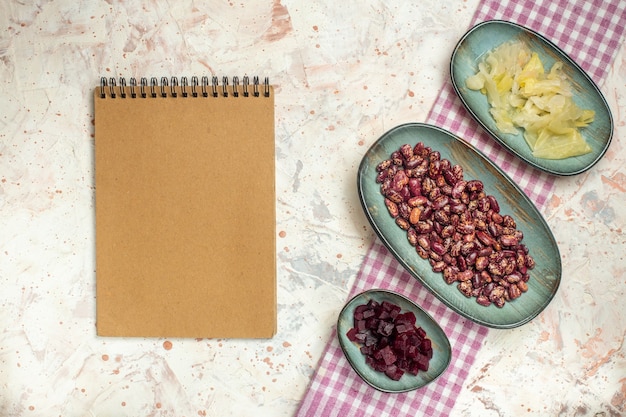I’ll admit it, I’m a bit obsessed with beans. They’re such a versatile ingredient, and I love the satisfaction of creating a pot of perfectly cooked beans from scratch. pinto beans, with their creamy white colour and speckled brown dots, are a particular favourite. They're the foundation of so many delicious dishes, from hearty chili to creamy dips and refreshing salads. But let's be honest, sometimes figuring out how long to cook them can feel like a culinary puzzle.
Today, I’m going to demystify pinto bean cooking time, sharing everything I’ve learned about achieving that perfect texture and flavour. Grab a cuppa, get comfy, and let's embark on this bean-tastic journey together!
(Part 1) The Basics of Pinto Bean Cooking

What are Pinto Beans?
Pinto beans are a type of common bean, hailing from the legume family. They're named for their speckled appearance, resembling tiny little "pintos" (meaning "painted" in Spanish). They’re known for their mild flavour, which makes them incredibly versatile. You can find them in everything from hearty stews to refreshing salads.
Why are Pinto Beans Worth the Effort?
Now, I know what you’re thinking: cooking dried beans from scratch seems like a lot of work. But trust me, the effort is totally worth it. The flavour of freshly cooked beans is simply unbeatable. You just can’t replicate it with canned beans, no matter how good they are.
Think of it this way: you’re essentially unlocking a depth of flavour that’s simply not possible with canned beans. Plus, the texture is far superior. You get that delightful tenderness and slightly creamy consistency that just melts in your mouth. And let's not forget the budget-friendly aspect! Homemade beans are a fantastic way to stretch your grocery budget.
Choosing the Right Pinto Beans
You’ll find pinto beans in various forms: dried, canned, and even pre-cooked. But if you want the best flavour and texture, always go for dried pinto beans. They offer a more nuanced flavour and a delightful, satisfying chewiness. It's a bit of a culinary adventure, discovering the subtle nuances of taste that emerge when you cook from scratch.
When buying dried beans, check the packaging for any signs of damage or insects. They should have a fresh, earthy aroma. Avoid beans that have a stale smell or any signs of moisture. This is a good tip for any dried bean you're buying.
Preparing Pinto Beans for Cooking
Before cooking, give those beans a good rinse under cold water. This helps remove any dust or debris and ensures a clean taste. Then, pick through the beans to remove any damaged or discoloured ones. You want to start with the best beans possible for the best results.
Soaking the Beans (or Not)
Now, here’s where opinions differ. Some swear by soaking, others skip it entirely. soaking beans overnight helps them cook faster and more evenly. It also softens the beans, making them easier to digest. This is especially helpful for people with sensitive digestive systems.
If you’re in a hurry, you can skip soaking. Just add the beans to cold water and bring them to a boil. Then, simmer for longer, adding extra cooking time to compensate for not soaking. But be prepared for a longer cooking time.
(Part 2) The Art of cooking pinto beans

How Long to Cook Pinto Beans?
The cooking time for pinto beans depends on several factors:
- Whether you soaked them or not: Soaked beans will cook faster than unsoaked ones.
- The amount of beans you’re cooking: A larger quantity of beans will take longer to cook. Think about it, the more beans you have, the more space they take up in the pot and the longer it takes for the heat to penetrate.
- The altitude: At higher altitudes, beans take longer to cook due to the lower boiling point of water. This is because water boils at a lower temperature at higher altitudes, which means it takes longer for the beans to cook through. If you live in a mountainous area, you might need to adjust your cooking time accordingly.
- The type of pot: A heavy-bottomed pot retains heat better and helps beans cook more evenly. This ensures that the beans cook through evenly without getting mushy.
Here’s a general guideline:
| Soaked Beans | Unsoaked Beans |
|---|---|
| 1-2 hours | 2-3 hours |
The Perfect Cooking Technique
For the most delicious and perfectly cooked pinto beans, here’s my foolproof method:
1. Rinse and pick: Give the beans a good rinse and pick through them for any bad ones. This is a crucial first step to ensure clean and flavourful beans.
2. Soak (optional): If soaking, cover the beans with water by at least 2 inches and soak for 8-12 hours. This is the key to faster and more even cooking.
3. Bring to a boil: Drain the soaked beans (if you soaked them) and add them to a large pot with fresh water, covering the beans by at least 2 inches. Bring to a boil. You want the beans to be fully submerged in water to cook evenly.
4. Simmer: Reduce the heat to a gentle simmer. Skim off any foam that rises to the surface. This helps to ensure clear broth and prevent any unwanted bitterness.
5. Cook until tender: Cook until the beans are tender but not mushy. This will take about 1-2 hours for soaked beans and 2-3 hours for unsoaked beans. It’s all about finding that perfect balance between tenderness and firmness.
6. Season: Add salt and any other desired seasonings towards the end of the cooking time. Adding salt too early can actually prevent the beans from softening properly.
7. Check for doneness: To test for doneness, mash a bean against the side of the pot. It should easily break down and release its starch. This is a great way to ensure the beans are cooked through.
Troubleshooting Common Problems
Beans are too hard: This can happen if you didn’t cook them long enough. Simply simmer for longer until they reach the desired tenderness. Patience is key with beans!
Beans are mushy: This could be due to overcooking. If they're just slightly overcooked, you can salvage them by adding them to a recipe that calls for mashed beans, like a chili or dip. Sometimes a little overcooking can be a blessing in disguise.
Beans haven’t softened: This usually happens with old beans. Try soaking them for longer, or consider using a pressure cooker to cook them faster. It’s important to use fresh beans for the best results.
(Part 3) Mastering the Art of Bean Cooking

Using a Pressure Cooker
For busy cooks, a pressure cooker is a lifesaver! It can significantly cut down on cooking time, allowing you to have perfect pinto beans ready in just 30-45 minutes. It's a fantastic way to get a delicious meal on the table quickly.
Here’s a simple guide:
1. Rinse and pick the beans. Always start with clean beans.
2. Add them to the pressure cooker with fresh water, covering the beans by at least 2 inches. Make sure the beans are submerged in water.
3. Seal the pressure cooker and cook according to the manufacturer’s instructions. This typically involves bringing the pressure cooker to high pressure and then cooking for 15-20 minutes. It's essential to follow the instructions for your specific pressure cooker for safety.
4. Once the cooking time is up, allow the pressure to release naturally for 10 minutes before releasing the remaining pressure. This helps prevent splattering and ensures the beans are properly cooked.
5. Season to your liking and enjoy!
Adding Flavour to Your Pinto Beans
While pinto beans are delicious on their own, adding a few flavour boosters can really take them to the next level. Here are some of my favourite additions:
Onion and garlic: These aromatic ingredients add depth and richness to the beans. They’re a classic combination for a reason.
Bay leaf: A bay leaf adds a subtle herbal aroma. It provides a delicate, earthy note.
Cumin and chili powder: These spices create a warm, earthy flavour profile. They add a touch of warmth and complexity.
Smoked paprika: For a smoky kick, add a pinch of smoked paprika. It lends a beautiful smoky flavour.
Fresh herbs: Chopped parsley, cilantro, or oregano add a burst of freshness. They provide a vibrant and aromatic touch.
Salt and pepper: Season to taste, but remember, salt will help the beans soften. Salt is essential for flavour, but don’t add it too early, as it can hinder the softening process.
Storing Cooked Pinto Beans
Once your beans are cooked, you can store them in the refrigerator for up to 5 days. Simply transfer them to an airtight container and refrigerate.
To reheat, simply place the beans in a saucepan with a little bit of water and simmer until heated through.
You can also freeze cooked pinto beans for up to 3 months. To freeze, simply transfer them to a freezer-safe container or bag and freeze. Thaw in the refrigerator overnight before reheating.
(Part 4) Pinto bean recipes: Beyond the Basics
My Favourite pinto bean recipes
Okay, let’s talk about the deliciousness! Here are a few of my favourite pinto bean recipes that showcase their versatility:
1. Classic Chili
Pinto beans are the star ingredient in a hearty and flavourful chili. They add texture, protein, and a comforting warmth. It’s a classic comfort food for a reason.
2. Creamy Bean Dip
For a satisfying and healthy snack, try this creamy dip made with pinto beans, avocado, lime juice, and cilantro. It’s perfect for dipping chips, veggies, or crackers. It’s a delicious and easy crowd-pleaser.
3. Tex-Mex Salad
A vibrant and colourful salad featuring pinto beans, corn, black beans, tomatoes, onions, cilantro, and a tangy lime dressing. It's a fresh and flavourful salad that’s perfect for warmer weather.
4. Vegetarian Burgers
Pinto beans are an excellent source of protein, making them a perfect addition to veggie burgers. Combine them with other vegetables and spices for a satisfying and flavourful patty. It’s a delicious way to enjoy a vegetarian burger.
5. pinto bean soup
For a comforting and warming meal, try a simple and delicious pinto bean soup. It’s perfect for a cold winter day and can be made with a variety of vegetables and spices. It’s a hearty and satisfying soup that’s perfect for chilly evenings.
(Part 5) Pinto Bean Cooking: Tips and Tricks
1. Don’t Overcrowd the Pot
When cooking beans, give them plenty of room. Overcrowding the pot can prevent them from cooking evenly and can lead to mushy beans. It’s important to give those beans some space.
2. Use Cold Water
Always start with cold water when cooking beans. This allows the beans to cook gradually and evenly. It’s essential for even cooking and a smooth texture.
3. Don’t Add Salt Too Early
Adding salt too early can prevent the beans from softening properly. Wait until the end of the cooking time to season them. This is a crucial tip for achieving perfectly tender beans.
4. Check for Doneness
To ensure your beans are cooked to perfection, check for doneness regularly. A properly cooked bean should be tender but not mushy. It's all about finding that perfect balance.
5. Store Cooked Beans Properly
Once cooked, store pinto beans in the refrigerator for up to 5 days or in the freezer for up to 3 months. This will help to preserve their flavour and texture. It’s important to store them properly to maintain their quality.
(Part 6) Exploring Beyond Pinto Beans: Other bean varieties
The Wonderful World of Beans
Beyond pinto beans, there’s a whole world of beans to explore! Each variety has its own unique characteristics, flavours, and uses.
Black Beans
Known for their earthy flavour and firm texture, black beans are a staple in many Latin American dishes. They're often used in salsas, dips, and soups. They add a rich and smoky flavour to any dish.
kidney beans
These reddish-brown beans have a rich, earthy flavour and a firm texture. They’re commonly used in chili, stews, and salads. They bring a vibrant colour and hearty texture to dishes.
Chickpeas
With their nutty flavour and creamy texture, chickpeas are incredibly versatile. They’re a key ingredient in hummus, falafel, and curries. They're a fantastic source of protein and fibre.
cannellini beans
These large, white beans have a mild flavour and a creamy texture. They’re often used in Italian dishes, like pasta e fagioli. They add a satisfying creaminess to soups and stews.
(Part 7) The Benefits of Eating Beans
A nutritional powerhouse
Beans are a true nutritional powerhouse, packed with essential vitamins, minerals, and fibre. They're a fantastic addition to a healthy diet.
High in Protein
Beans are a great source of plant-based protein, making them an excellent choice for vegetarians and vegans. They provide a complete protein profile.
Rich in Fibre
The high fibre content in beans helps promote digestive health and can help you feel full and satisfied. Fibre is essential for a healthy digestive system.
Low in Fat
Beans are naturally low in fat, making them a healthy and heart-friendly choice. They’re a great way to enjoy a nutritious meal without the added fat.
Rich in Vitamins and Minerals
Beans are a good source of iron, folate, magnesium, and potassium. They’re packed with essential nutrients for overall health.
(Part 8) Embracing the Bean-Loving Lifestyle
Bean-Inspired Dishes
Beans are incredibly versatile and can be incorporated into a wide range of dishes. From hearty stews and soups to salads, dips, and even desserts, there's a bean recipe for every taste bud. They’re truly a versatile ingredient.
Exploring New Flavours
Don't be afraid to experiment with different bean varieties and flavour combinations. You might be surprised at the delicious and unexpected results! Get creative and try new things.
Sharing the Bean Love
Beans are an affordable and sustainable food option. Share the bean love with others and encourage them to explore the world of beans. Spread the word about the benefits of beans!
FAQs
1. Can I use canned pinto beans instead of dried beans?
You can use canned pinto beans, but they won't have the same flavour or texture as cooked dried beans. They're often more mushy and can have a slightly bland flavour. It's best to use dried beans for the best results.
2. How long can I store cooked pinto beans?
Cooked pinto beans can be stored in the refrigerator for up to 5 days or in the freezer for up to 3 months.
3. What if my beans are still hard after cooking for the recommended time?
If your beans are still hard after cooking for the recommended time, they may be old. Try soaking them for longer, or consider using a pressure cooker to cook them faster.
4. Can I cook pinto beans in a slow cooker?
Yes, you can cook pinto beans in a slow cooker. Simply rinse and pick the beans, add them to the slow cooker with water, and cook on low for 6-8 hours or on high for 3-4 hours.
5. How do I know when pinto beans are done?
To check for doneness, mash a bean against the side of the pot. It should easily break down and release its starch. You can also try eating a bean to see if it's tender enough.
Everyone is watching

Corn on the Cob: The Ultimate Guide to Perfectly Cooked Ears
Healthy MealsAh, corn on the cob. Just the name evokes images of sunny days, barbecues, and that sweet, juicy flavour that ...

Perfect Pork Roast Oven Cooking Time: A Guide to Delicious Results
Healthy MealsThere's something truly satisfying about a perfectly roasted pork. The aroma alone is enough to make your mout...

Ham Cooking Time: How Long to Bake, Smoke, or Boil a Delicious Ham
Healthy MealsAh, ham. It's a classic, isn't it? A real crowd-pleaser, especially around holidays. And when done right, it'...

Scallops: The Ultimate Guide to Perfect Cooking
Healthy MealsAh, scallops. Those delicate, sweet, and utterly delicious morsels of the sea. They hold a special place in my...

Spaghetti Squash: The Ultimate Guide to Cooking and Serving
Healthy MealsRemember that time you saw spaghetti squash at the supermarket, looking all bumpy and strange, and thought, "W...
